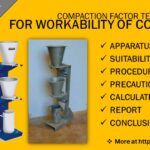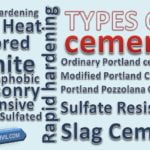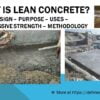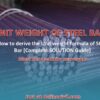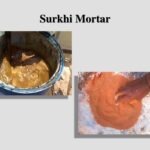Do you know the Atterberg limits define the three critical water content limits of a fine grained soil?
Yes! Atterberg limits are consistency limits of soil that define the water content at which the soil changes from one state to the other on addition or removal of water content.
Fine-grained soil, especially clayey soils changes their attributes or characteristics upon addition or expulsion of water content.
Before we can go deep of what Atterberg limits are or why are they important?
Let’s quickly revise about the four states of soil. A fine grained soil must be in any of the following consistency states depending on the water content in them:
- Solid state
- Semi-solid state
- Plastic State
- Liquid State
Clayey soils when added with water content expand in volume and this expansion depends on the structure or mineralogical characteristics of soil. Silt, clay, and sand have a different mineralogical character.
Thus their percentage in any type of soil would drastically change the behavior or character under loading. Clayey soils upon addition of water expand and upon variation of water content may shrink as well.
While doing so, they also have variable value of shear strength which is a very important parameter of soil considered during design of foundation for structures.

Now, Alber Atterberg or Albert Mauritz Atterberg, who was a Swedish Chemist and an agronomist has created a limit to classify clay particles. During his study on different types of soils, he found plasticity to be a particular characteristics of clayey soils and as a result he defined consistency limits that were later named after his name as “Atterberg Limits”. Later on, Arthur Casagrande and Karl Terzaghi (renowned as pioneers of soil mechanics) further refined the limits.
[su_box title=”Recommended for you” box_color=”#df6804″ radius=”9″ id=”social_definecivil”]Isolated foundation >>> A very informative and in-depth article just like you’re reading.[su_button url=”https://definecivil.com/isolated-footing/” target=”blank” style=”3d” size=”5″ center=”yes” icon=”icon: check” rel=”nofollow”]Read Now[/su_button] [/su_box]
What are Atterberg limits used for?
Now that you’ve got the definition and basics of Atterberg limits covered, let’s new see why are Atterberg limits important?
Atterberg limits define the consistency or engineering properties of fine-grained soils. Experts and geo-engineers use Atterberg limits to distinguish between silt and clayey soils or even they can further classify between different types of silts and clays.
During design phase of a structure or building, designers specify the soil to be have a suitable value of Atterberg limits to ensure the apt amount of shear strength and so the soil won’t go extensive change in volume upon addition of water content from the underground water table.
Different types of tests are performed in geotechnical laboratory to determine various limits of soil. We’ll go in detail later in this article.
Now let’s define these Atterberg limits keeping in view the various states of fine-grained soils (described above).
Liquid Limit
Liquid limit abbreviated as LL is the water content at which the clayey soil changes from plastic state to the liquid state. In simple terms liquid state is that in which soil doesn’t have any shear strength i.e. it just collapses. The liquid limit of the soil is determined in the laboratory by two famous methods i.e. Casagrande’s method and fall cone method.
Casagrande’s method
In Casagrande’s method, a special metallic bowl apparatus is used which is 10 to 12 cm in diameter. The soil, after mixing with suitable amount of water content, is mixed and placed in the device. A standard spatula is used to make a groove of 2 mm in depth. The cup is rotated within the apparatus by rotating the handle and as a result of the impact gradually close over a distance of 12.7 mm. This test is repeated and a graph is made between number of blows and water content.
From the graph, the liquid limit is determined as the water content at which the 25 blows of Casagrande apparatus cause the groove to close over a distance of 12.7 mm.
So, Casagrande defined liquid limit as the water content in which the 25 blows of standardized bowl would cause the grove to close over at a distance of 12.7 mm.
Now although there are various advantages of Casgrande apparatus and is thus widely used across America. But in Europe, fall cone test is used.
Americna Society for testing materials (ASTM) has standardized the Casagrande’s test method as D4318.
Fall Cone Test
Some European institutes rely on this method as it is less dependent on the operator capability in determining the liquid limit.
In this method, a standard stainless steel cone is used to penetrate the soil and the depth is noted. The cone has a specified apex angle, length and mass.
Plastic Limit
The plastic limit abbreviated as PL is the moisture content at which the soil begins to behave like a plastic material. It’s another soil consistency state that defines the moisture content above which the water will destroy the cohesion of the soil. At plastic limit, the soil will crumble when rolled into thread of 3.2mm (1/8 in) in diameter.
ASTM D4148 has standardized this method as determination of plastic limit of soil. In this method the soil was first taken as an ellipsoidal mass in weight of 1.5 to 2 grams. After that the mass is rolled between the palm or fingers and then on glass plate with sufficient pressure to roll the mass into a thread of uniform diameter throughout its length.
The thread is further deformed to reach diameter to 3.2mm taking no more than 2 minute. Now when the diameter of the soil becomes 3.2 mm (comparing it with the standard needle), break the specimen into several pieces. Now knead the soil into an ellipsoidal mass and repeat the procedure until the time when soil can no longer be rolled into a 3.2 mm diameter thread.
At the end the water content is determined using oven dry method. That water content is termed as the liquid limit.
[su_box title=”Recommended for you” box_color=”#df6804″ radius=”9″ id=”social_definecivil”]Field Density test methods for Soil Compaction >>> A very informative and in-depth article just like you’re reading.[su_button url=”https://definecivil.com/field-density-test/” target=”blank” style=”3d” size=”5″ center=”yes” icon=”icon: check” rel=”nofollow”]Read Now[/su_button] [/su_box]
Plasticity Index
Let’s now see what plasticity index is and how to determine plasticity index of soil? Plasticity index also terms as plastic index of soil (PI) gives us an idea about plasticity of soil. Theoretically is the difference between the Liquid limit and plastic limit. Plasticity index defines the range of water content on the plasticity index chart in which the soil shows plastic properties.
How to calculate the plasticity index?
We can calculate the plasticity index with the help of plasticity index formula. It is defined as following equation:
PI = Liquid limit – Plastic Limit = LL – PL
A soil having high value of PI tends to be clayey soils whereas silts have lower value of PI. A soil with PI=0 is called non-plastic soil or sandy soil. Experts describe soil on the basis of plasticity index as :
[su_table responsive=”yes”]
| Plasticity Index | Type of Soil |
| 0 | Non-plastic |
| <7 | Slightly plastic |
| 7 to 17 | Medium plastic |
| >17 | Highly plastic |
[/su_table]
Liquidity Index
When the soil is in plastic state the liquidity index varies from 0 to 1. At the plastic limit, the liquidity index is zero while at the liquid limit it is 1. The water content in between the liquid and plastic limit, the liquidity index varies from 0 to 1.
In general we can say with the increase in water content of the soil its liquidity Index increases and with it soil’s liquidity increases and firmness decreases.
We must note here that Liquidity index is used for the same purpose as the consistency index that is to scale the water content of the soil. Consistency index and liquidity index are related to each other as sum of Liquidity index and consistency index will always be equal to 1.
It can be calculated as a ratio of difference between natural water content, plastic limit, and liquid limit: LI=(W-PL)/(LL-PL)
where W is the natural water content
PL is the plasticity index or PL = LL – PL
LL is the liquid limit

